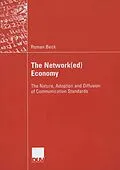In an increasingly globalized and networked world modern communication channels and new electronic media standards are constantly changing traditional interaction patterns of humans and even machines. Communication-based interaction is of pivotal economic importance and the availability of generally accepted electronic communication standards is essential in order to decrease communication-related transaction costs.
Roman Beck combines the theories of diffusion and network effects and presents a new goods classification model to explore the dissemination of IT and e-business standards. On this basis he designs two applications that support and improve firms' electronic interlaced communication by means of automation and standardization effects. He then examines how network effects drive the diffusion of communication standards and develops a model which is implemented as a simulation to show the dynamic interplay between direct and indirect network effects during the diffusion process. It also addresses critical mass and life cycle issues, as well as related utility changes in communication standards. The author concludes by detailing the connections between the new model and existing literature on network effects.
"Roman Beck breaks new ground in explaining the role of communication standards in the creation of positive network effects that have become central to the knowledge economy. This work is required reading for those interested in the mechanics and implications of adoption and diffusion of communication standards."
John Leslie King
Dean and Professor
School of information
University of Michigan, USA
Autorentext
Dr. Roman Beck ist wissenschaftlicher Assistent von Prof. Dr. Wolfgang König am Institut für Wirtschaftsinformatik der Universität Frankfurt/Main.
Zusammenfassung
Modern communication channels together with new electronic media stan dards are constantly changing traditional interaction patterns of humans and even machines In an increasingly globalized and networked world. Such a communication-based interaction is of pivotal economic importance in order to manage efficiently inter-organizational cooperation and business information flows. Consequently, the availability of generally accepted electronic commu nication standards is essential in order to decrease communication-related transaction costs. Roman Beck elaborates in his dissertation The Network(ed) Economy the im portance of the so far independently from each other discussed diffusion the ory on the one hand and network effect theory on the other hand. However, Roman Beck not only connects the two theories epistemologically, but also develops and extends those theories by providing a network diffusion model. The core of his model is the so-called network effect helix, where a dynamic and self-enforcing interplay between direct and indirect network effects is de ployed to simulate diffusion patterns and paths of communication standards. In his analysis, Roman Beck especially focused on the critical diffusion period be tween the market launch of a new communication standard and (in case of a successful diffusion) the achievement of a critical mass of adopters. His re search results and consequently the chosen title of the thesis are capable to il lustrate the overall topic of his work in the interesting area between an incom pletely interconnected "networked economy" on the one hand and a com pletely interconnected "network economy".
Inhalt
Diffusion and Innovation Theory.- Network Effect Theory.- Diffusion of E-Business Standards: Empirical Results.- Developing E-Business Standards.- Simulation of the Diffusion of Network Effect Goods.- Conclusions.- Future Research.
